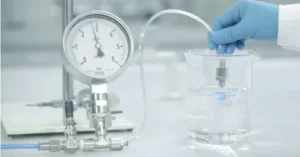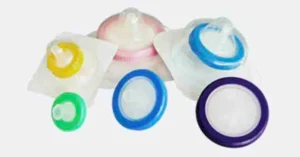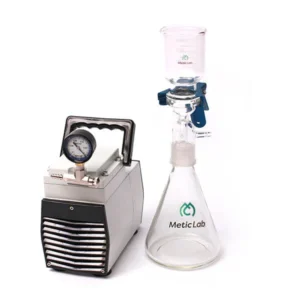
Many people are unfamiliar with the appearance of a syringe filter, much less have enough knowledge on how to properly operate one. If you fall into this category and you need a quick guide on the concept and use of syringe filters, then this article is here to help you!
If you’ve worked in a laboratory on High-Performance Liquid Chromatography (HPLC) or worked with culture media preparation or DNA extraction, you would have come across a device called a syringe filter and the first thing you probably noticed was, IT IS SO EASY TO USE! Due to their simple design and ease of use, they are available in so many types and for a variety of applications. In this blog, I will delve into the types of syringe filters, their uses, and how you can choose one based on your requirements.
A syringe filter is a small, membranous tool that is used conjointly with a syringe to separate particulates from a liquid or gaseous mixture, they are also used to remove particles from a liquid sample before analysis so that the equipment doesn’t break.
How does Syringe Filter work?
A syringe filter is a single-use, membrane-based device, that is easily attached to a syringe and used to separate particles of a specific size from your gas or liquid samples. You must be wondering what makes syringe filters indispensable in labs. Sometimes, particles or certain impurities in samples can hinder analysis or even damage equipment that performs the analysis, like HPLC, ion-chromatography, etc. So, before analysis, the samples must be purified by passing them through a syringe filter. They are mainly used for small volumes, are simple to work with, quick to use, and are affordable.
As the name suggests, syringe filters consist of a plastic housing and a membrane. The liquid is forced to pass through a membrane filter of a particular pore size, which depends on the size of impurities that you are dealing with in your specimens. The filter prevents the passage of contaminants and there, is a perfect sample for your experiments!

Figure showing parts of syringe filter (1)
Here is a depiction of the general working of syringe filters.

Figure showing filter working (2)
How many varieties can I find?
To make syringe filters suitable for various kinds of samples, sample volumes, particulate sizes, and whether you want to recover your sample or not, many kinds of syringe filters are available in the market, and I will be discussing the main variations of the device in this section.
What Pore size should I choose?
Just as we use different-sized sieves to strain out pasta or tea leaves, the pore size of the membrane in syringe filters varies according to its use and the size of particles to be retained. The size of pores ranges from 0.02mm to about 0.45mm. However, the most common sizes are 0.2mm and 0.45 mm (e.g., for use in HPLC)
Various applications concerning the pore size of the membrane are given below.
Pore size Application
0.1mm
0.22mm
0.45mm
>45mm
Sample sterilization (mycoplasma removal)
Bacteria removal or for ICP-MS
(Inductively coupled plasma mass spectrometry)
General filtration and particle removal
Mostly used for pre-filtration
Main membrane material of syringe filter
There are mainly three things to keep in mind while selecting a material for your filter membrane: chemical compatibility with the sample, the flow rate that you desire, the burst pressure (or strength) of the filter and effective filtration area (EFA), which affects the capacity of the filter.

There are multiple factors to be considered while selecting a filter, and it sure can be a daunting task to pick a filter that meets all your requirements and also provides efficient filtration.
How do I choose the syringe filter diameter?
The diameter of your filter affects the amount or volume of the sample you can filter. Generally, 13mm diameter is used for sample volumes less than 10mL, 25mm diameter for volumes less than 100mL, and for volumes less than 250mL, 33mm diameter filters are available.
This is only a general guideline and the amount of sample you can filter will also depend on the sample characteristics. For e.g., if your sample has high particulate matter, the pores might clog quickly and the amount you can filter would be less. It is better to research your needs and optimize your filter by trial and error.
Luer slip and Luer lock
If you are also confused about these two like I am, here’s a simple solution.
If you are looking to work with solutions that give high back pressure while filtering and don’t want to risk the filter slipping off, which could lead to sample loss, go for Luer lock fitting. Luer lock ensures that the filter membrane is twisted into a locking system and fits into place while it’s attached to the syringe. It can only be fit onto Luer lock syringes. There is no risk for the filter to pop off from the syringe.
However, if you are working with low back pressure samples and don’t mind risking sample loss, Luer slip might be the right choice for you. The Luer slip fitting filter can be used with almost any kind of syringe and is very easy and quick to use.

Figure showing Luer lock and Luer slip fitting (3)
What else should I know?
One more thing to consider is that sometimes your particle load might be high and that could lead to your filter getting clogged. So, it’s better to pre-filter your samples with a larger pore-size filter (mostly GMF) to remove the bulk of the particles. Particular materials are more suitable for higher pore sizes while others are not, so manufacturers consider all those variables while producing syringe filters. You should choose one that suits your needs from the website and look into all the specifications while doing so.
You can also buy sterile filters if contamination could be an issue in your experiments.
MeticLab provides a wide configuration of filters to meet all your needs.
Here is a link to our website, where you can take a look at a range of products to choose from Meticlab.




